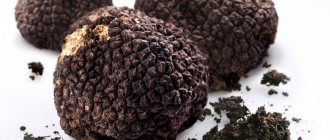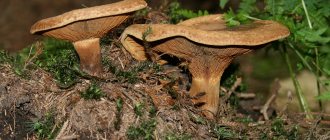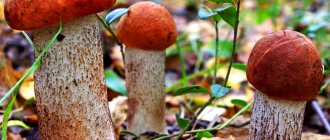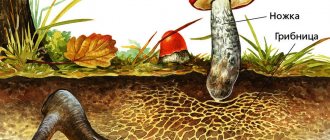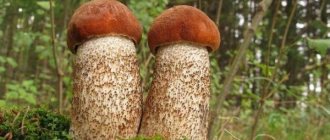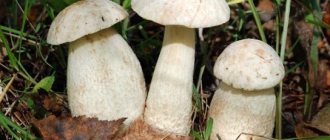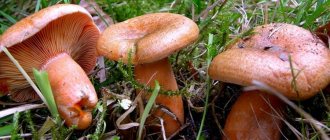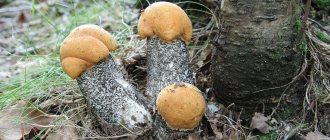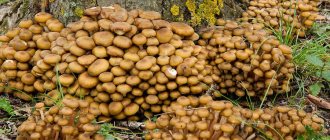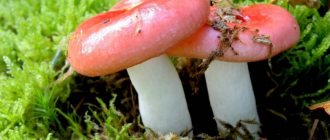Boletus
Boletus is a variety of well-known mushrooms. They received their unusual name not only because of the place of germination, but also from the word “autumn”. The color of the cap of this mushroom is very similar to the colors of autumn foliage. When it falls, the boletus merges into one color with the fallen leaves. There are many varieties of these mushrooms. All of them have a unique taste and are very useful for humans.
Types of boletuses
Yellow-brown (red-brown) boletus
Yellow-brown boletus (Leccinum versipelle)
The largest among all representatives of these mushrooms. The cap can reach 30 cm in diameter. Often inexperienced mushroom pickers are afraid and pass by such a boletus, which is completely in vain; it is quite easy to distinguish it from a false one. The mushroom must be broken, in the damaged area it should first acquire a pinkish tint, and then purple.
Red boletus
Red boletus
This mushroom is much easier to recognize. Its cap has a deep red color and is most noticeable among the foliage, even from afar. The pulp is fleshy and very dense. The legs are white with small scales. Mushroom pickers should not be afraid of unusual changes when collecting this species. When the mushroom is cut, the damaged area acquires a blue tint and then turns black.
Pine boletus
Pine boletus (Leccinum vulpinum)
The diameter of the cap of this type of mushroom can reach 15 cm. The color is brown-red, and over time it acquires a crimson hue, which does not even look natural. Externally it has a velvety appearance. The peculiarity of the mushroom is to change the color of the pulp. This does not depend on damage; this process occurs on its own during growth and maturation.
White boletus
White boletus
The name of the mushroom speaks for itself about its color. Both their cap and stem are pure white. Although this applies only to young representatives of mushrooms. Large mushrooms are gray in color. In a broken place they acquire a blue tint, which soon turns black.
Painted-legged boletus
Colored-legged boletus
This mushroom is slightly different from other boletuses. It is characterized by a pink cap, which can be either flat or convex. Its leg is covered with pinkish scales. The color at the base is rich yellow, gradually turning into white and pink towards the top. This variety is especially loved by insects and various kinds of worms.
Redhead oak boletus
Oak boletus (Leccinum vulpinum)
Young representatives of this species are very unusual. The hat looks like a thimble placed on a finger. Its edges fit tightly to the stem, giving the mushroom a spherical shape. Over time, the diameter of the cap can increase to 30 centimeters. Mushroom pickers are very fond of the Redhead mushroom, it is tasty and looks aesthetically pleasing. In older mushrooms, the cap takes on a cushion shape. The color of the cap becomes red mixed with orange tones. Mature mushrooms are characterized by a velvety texture. The leg is white with reddish scales and shaped like a cylinder. It can reach a height of 20 cm and a thickness of up to 5 cm. The scales on the legs quickly darken, which indicates the growth and maturity of the mushroom. The lifespan of this species is very short. Only 11 days. The older you get, the more decrepit the mushroom pulp becomes.
Spruce boletus
Spruce boletus (Leccinum peccinum)
The color of the cap is brown-red. Can reach up to 10 cm in diameter. The skin is not smooth, it hangs slightly from the base, forming a slight overlap over the stem. The cap is covered with small scales, slightly lighter than the main tone. The length of the leg reaches 13 cm, and the thickness reaches three. The mushroom got its name due to the places where it germinates. They can be found in spruce, coniferous forests, and oak forests. These mushrooms grow in large groups.
Black-scaled boletus
Black-scaled boletus
The habitat of this species is solitary aspen trees. The color of the cap has a reddish-brick tint. Young individuals have a velvety, matte cap. As she ages, she becomes “naked.” The shape at first resembles a ball, and as it grows it becomes more like a pillow. The stems of young mushrooms are white and gradually turn gray with an olive tint. The height of the leg can reach 18 cm. It is covered with reddish scales. When cut, the mushroom immediately acquires a purple color, and after a while it changes to black.
There are other types of boletuses, described earlier - these are the main ones.
Growing at home and in the country
Many gardeners cultivate mushrooms in their garden plots. Red boletus can also be grown, but the easiest way to do this is to buy ready-made mycelium in a specialty store.
To grow boletus, a necessary condition is the presence of deciduous trees on the site, as well as shade.
To grow this mushroom you will need:
- mycelium;
- wood, preferably aspen, oak or birch;
- sawdust, fallen and rotted leaves, rotten remains of aspen, oak, poplar or birch;
- cow manure, maybe horse manure;
- polyethylene.
The best time for planting mycelium and developing mycelium will be the summer period. You can plant from May to September. You will need to prepare compost, for this you need to do the following:
- lay leaves and wood debris on the film in layers in a ratio of 9 to 1;
- pour warm water over everything;
- after a week, turn over with a shovel to create a homogeneous mass;
- after 5 days you can use it.
Now you need to start a mushroom bed:
- Dig a hole with an area of 2 square meters near the selected tree. m and depth 30 cm.
- Fill to the top with prepared compost.
- At a distance of 30 cm, mark holes up to 20 cm deep.
- Dip the mycelium into them and sprinkle with soil.
- Pour at least 40 liters of water over the indicated area.
- Cover with leaves or forest litter on top.
Important! Such rows will welcome watering with a sugar solution prepared from 10 g of sand per 10 liters of water.
Soil moisture should be constantly monitored, especially when extreme heat sets in. For the winter, it is recommended to cover with a thick layer of fallen leaves. Such a bed will bear fruit for up to 5 years.
Where do aspen mushrooms grow?
A variety of these mushrooms can be found in almost any forest. They grow in the Far East, Siberia, the Caucasus and even in Europe. As with any mushrooms, the wetter the weather, the more there are. The collection begins from the beginning of summer until the end of September. It happens that they can be found until frost. Some types of boletus prefer special growing conditions. White boletus - prefers deciduous or mixed forests with high humidity. Mushroom pickers should remember that it is listed in the Red Book.
Yellow-brown representatives can be found in pine and birch areas. Their favorite habitat is under a fern leaf.
Red ones - they choose young single aspen trees, although they are often found by mushroom pickers in pine, mixed and deciduous forests. This variety of boletus should be looked for in clearings, near roads and in the grass.
Pine - they love dampness, they can be collected in coniferous forests.
For boletuses, the most important thing is that direct sunlight does not penetrate into their habitats and that a light, cool breeze blows.
Habitat
Red boletus is widespread throughout the forest zone of Eurasia. It can be found even in the north, in the tundra, among dwarf birches. In the CIS countries this is the European part, North-West Russia, the Caucasus, the Urals, Western Siberia, and the Far East. They prefer rocky soil, rich in leaf humus, and moderately moist soil.
Where does red boletus grow? Unlike some of its closest relatives, the mushroom does not have strictly one partner tree with which it enters into symbiosis. It forms mycorrhiza (symbiosis with the roots of the plant) with many deciduous trees: poplar, less often willow, as well as oak, beech, hornbeam, birch. But it gives preference to aspen - it is especially abundant above its roots. Does not grow near coniferous trees.
Where to collect red boletus? The fungus prefers young trees. First of all, these are pure aspen forests or single aspen trees. It can also be found in mixed or deciduous woodlands, in clearings, forest edges, and along forest roads.
It grows singly or in families, often quite large.
False boletus
General distinctive features of boletus
The variety of this group of mushrooms is the safest. However, when picking, inexperienced mushroom pickers often have doubts about how not to make a mistake and bring home a false mushroom.
Regardless of the type of boletus, its leg has the shape of a cylinder, but only in young individuals. With growth, the leg increases, and the cap, on the contrary, stops growing. It seems that the mushroom is of a disproportionate, disturbed shape. In very mature mushrooms, the cap grows and reaches 20 cm in diameter. It is pleasant to the touch - velvety and dry. On the inside of the cap there is a tubular layer. Depending on ripeness, they have a white or grayish tint, which turns black when pressed.
The leg is velvety and slightly rough to the touch. Its distinctive feature is the presence of scales. They form as the fungus grows. In a damaged area, the real boletus shows metamorphosis: first it turns blue, then acquires a black color. This is the main distinguishing feature.
Doubles
Gall mushroom (gorchak)
In places favored by boletuses, you can find false mushrooms that are very similar to them. The most common lookalike is gall fungus (gorchak) . You won’t find it in deciduous forests; it grows only in coniferous forests. A favorite place is under the spruce and pine trees. In order not to be deceived, you need to pay attention to the distinctive features.
If, after checking, this mushroom ends up on the table, then there is no need to panic. It does not contain poisons, but the name speaks for itself. The mushroom has a very bitter taste and if it gets mixed with the rest, it will spoil the dish when fried. It is impossible to eat, it resembles the bitterness of bile.
Despite the fact that there are no poisons in this mushroom, it is still undesirable to taste it; the bitterness is converted into toxins, settles in the liver and can cause severe intoxication in the body. The principle when picking mushrooms is – if you don’t know, don’t take it.
There are no false boletuses in nature. There is only a double - bitterling . They can't get poisoned. Therefore, even inexperienced people collect these mushrooms; it is quite difficult to confuse them with others.
How to process
Red boletus is one of the mushrooms that, after collection, require minimal pre-processing, which consists of the following:
- The mushrooms are carefully examined, rejecting wormy and rotten specimens. Individual damaged areas are cut out.
- Wipe with a sponge to remove dirt, soil, forest debris, etc.
- There is no need to soak red boletuses; just rinse them thoroughly in running water.
- There is also no need for pre-boiling before the main cooking.
The disadvantages of red boletus include the fact that after any processing, including drying, it darkens, which is not a sign of spoilage. The taste properties of the mushroom remain unchanged. This can be avoided by pre-soaking the prepared mushrooms in a 0.5% citric acid solution.
Composition and beneficial properties of boletus
These mushrooms are 90 percent water. They are leaders in protein, vitamins, and amino acids content. Due to its low calorie content, this product is often included in all kinds of diets. It can be used by people suffering from diabetes. Despite the fact that mushroom proteins are of plant origin, in terms of richness and benefits, mushroom protein, in its composition, is very similar to meat protein. Mushrooms can act as an alternative to both meat dishes and cereals. This is facilitated by the presence of B vitamins in their composition.
It has been established and repeatedly proven that the use of boletus helps to cleanse the body and remove toxins. The rich broth helps fight viruses, colds and helps strengthen the immune system. Containing high levels of vitamins PP helps with anemia, their amount is the same as in the liver.
How to cook
Red boletus is a delicious mushroom that is not only a healthy food product that can benefit the body, but also provides satiety with a small amount of calories. The pulp of the mushroom is fleshy, thick, dense, and during heat treatment it retains its shape well and does not become overcooked. There are separate recommendations to use only the caps of red aspen boletuses in recipes, since the stems are somewhat harsh and fibrous.
The mushroom is boiled, fried, stewed. There are ways to use red boletus for preparing a wide variety of dishes: first, second, appetizers, various fillings. Served as a side dish for meat dishes. They cook pilaf. Goes well with all kinds of vegetables.
The most popular red boletus is combined with fried potatoes or meat.
Contraindications
In addition to its benefits, this product can cause harm to the body. If you have kidney or liver disease, mushrooms should not be included in your diet. This is heavy food and difficult to digest. Boletuses are the largest of all mushrooms and love to accumulate toxins. The older the mushroom, the more of them there are in this product. Therefore, when collecting, it is better to choose young mushrooms. You should not collect very mature ones. And under no circumstances should you pick mushrooms near busy highways or industrial plants.
When cutting, a significant part of the stem must be left in the ground. When seaming, mushrooms must undergo careful temperature treatment. There is a folk remedy to test mushrooms: you need to boil them with a peeled onion. This method has its place, but, unfortunately, it does not always work, and does not provide a 100% guarantee.
How to store
Red boletus is a universal mushroom and is suitable for all types of preparation: it is salted, pickled, frozen. The simplest and least troublesome way is drying.
When pickling, due to the presence of vinegar in the marinade, the mushrooms retain their original color and do not darken. Therefore, there is no need to pre-soak them in a solution of citric acid.
Preparation of boletus mushrooms and cooking recipes
Marinated boletuses
You can do whatever you want with boletus mushrooms. These mushrooms are dried, salted, pickled, fried with potatoes, and frozen. First, they need to be thoroughly cleaned.
- Drying . You need to choose large mushrooms. No need to wash, just wipe with a damp cloth. Cut the cap and stem into strips, about 1 cm thick. Place on a mesh. Small mushrooms – these can be dried whole and look amazing in soup. If there is no drying, then simply expose it to dry, hot weather; the process will not be quick, it may take a week. But the result will be a natural product, dried in a natural way. In bad weather, you can bring it into a well-ventilated area. This product in dried form is unique. The soup made from these mushrooms turns out rich and aromatic. This result cannot be achieved with fresh mushrooms.
- Freezing . The mushrooms must be thoroughly washed, cut and boiled in a saucepan for 40 minutes. Drain the water using a colander, cool, portion into bags and freeze. Can be stored for no more than two years.
- Salted boletus . Rinse the caps thoroughly and boil for 20 minutes. Place in a container, sprinkle with salt, place horseradish leaves and dill on top. Pour boiled water. You will need 2 cups of salt per bucket. Consume this snack no sooner than after a week, but you should not keep it for more than a month. The brine may darken, do not be alarmed.
- Pickled boletus . Wash the mushrooms and cut off the caps. There are housewives who have waste-free production, and they even scrape the legs, freeing them from scales. Boil the mushrooms for about 35 minutes, add spices. Everything here is to taste: salt, pepper, seasonings, bay leaf. Boil for another 5 minutes. Pour into jars and roll up. If you don’t want to get mushrooms in dark brine, you need to boil the mushrooms for 30 minutes and drain the water. Prepare the marinade, place the mushrooms in it and simmer for 10 minutes.
- Mushroom caviar . This is a very tasty and healthy dish. In addition to mushrooms, caviar contains many healthy vegetables. Wash the mushrooms, boil them, and grind them through a meat grinder. Separately fry onions, carrots, bell peppers. After frying, also pass through a meat grinder, combine with mushrooms and simmer for 20 minutes. Add spices to taste. Roll up.
- Boletus salad . Boil the mushrooms, cool. Cut into small pieces. Cut the pickled cucumber and boiled chicken breast into cubes. Mix with mushrooms, add mustard, season with mayonnaise and add salt. Celery – will add piquancy to the dish, but this is not a necessary product.
In addition to the above options, boletuses can be stuffed, made with spaghetti, or simply served as an appetizer for the holiday table. Use when making pizza and pies.
Mushroom picking
Boletuses grow in waves. The first fruiting begins in early June. You can go out for them on a “quiet hunt” until October. Mushrooms of the first layer are observed when winter crops begin to ear.
Massive and long-term fruiting occurs in mid-August. Under favorable conditions, this period may last until September. A slight appearance of fungi is observed in humid summers.
Yellow-brown boletuses grow in June and can please the eye until late autumn. White representatives also bear fruit from June to September. Almost all types of this fungus appear at a certain period.
Blackscale
Mushroom with an orange-red, brick or dark red cap. In young boletuses it is velvety, and in mature ones it is smooth. At first the cap is semicircular, and then becomes cushion-shaped.
Black-scaled boletus
The average size is about 8 cm. The leg grows up to 18 cm. The scales are dark, almost black. The white flesh quickly turns purple and then bluish-black.
Red
A variety of boletus that can form mycorrhiza with different species (deciduous). The sizes of mushrooms are different - the caps are from 4 to 15 cm, sometimes more. The legs are tall (up to 15 cm), massive (1.5-5 cm).
Red boletus
Possible red, red, red-brown color of the cap. The skin fits tightly to the cap, does not need to be cleaned, and has a velvety feel to the touch. The light leg is covered with darker scales. The flesh is white, turning blue at the break. The species is widespread, grows in warm weather - June-October.
